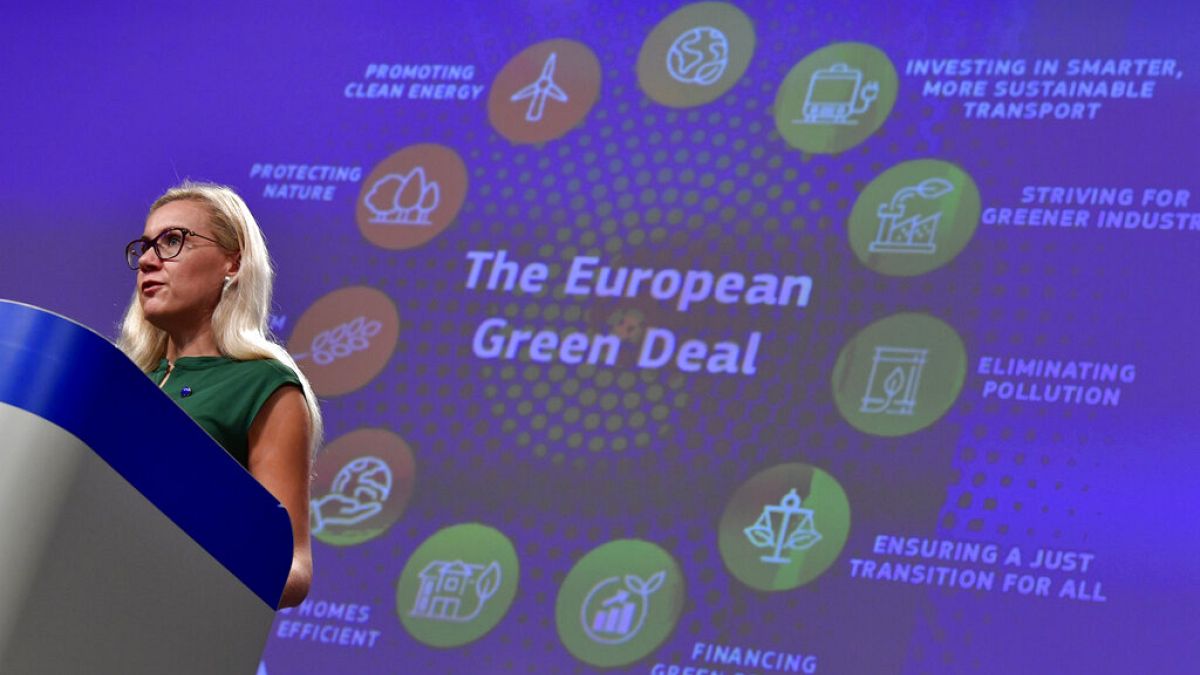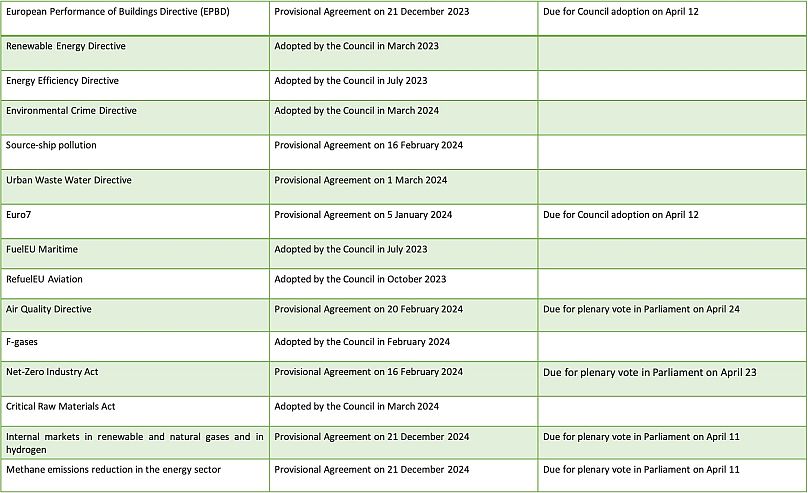The Green Deal shaped Ursula von der Leyen's mandate in hopes of establishing the bloc as a pioneer in the fight against climate change. With the European Commission President's mandate drawing to a close, what were the main green achievements and which laws were held back by MEPs?
Increased renewable and energy efficiency targets, less air pollution and tackling environmental crime were some of the achievements hailed by EU lawmakers driven by the European Green Deal, the EU’s leading climate agenda announced in 2019. The EU’s climate-neutrality plan vowed by 2030 to reduce greenhouse gas (GHG) emissions by at least 55% set against a 1990 benchmark, and to reach net zero by 2050.
Simone Tagliapetra, senior fellow at think tank Bruegel and professor of energy and climate policy with Johns Hopkins University, said von der Leyen has “successfully" pivoted the EU towards climate neutrality.
“With the Green Deal, the EU has set clear and ambitious climate targets for 2030 and 2050 and, to reach them, has adopted a wave of legislation. Hundreds of billions of euros in EU green funding have been mobilised,” Tagliapetra told Euronews.
But what were the main achievements and which laws were held back by lawmakers?
What Green Deal actions have been taken?
Despite repeated erosion in ambition during political negotiations, the EU’s green plan still delivered several laws to decarbonise the energy sector, buildings, industry and transport by 2050.
In 2021 lawmakers voted to make climate goals legally binding by adopting a European Climate Law. Shortly afterwards, the EU executive announced the ‘Fit for 55’, a pack of 13 legislative files designed to help all sectors of the EU economy and to ease the Green Deal’s implementation, which was quickly adopted.
The Commission’s so-called “Gas Package” opened the door to the deployment of renewable and low-carbon gases like biomethane and hydrogen in the energy sector, with new rules to mitigate methane emissions, a GHG which traps more heat in the atmosphere than CO2, all agreed by the co-legislators in December 2023.
The revision of the European Performance of Buildings Directive (EPBD), provisionally agreed in December 2023, is aimed at revamping old buildings and establishing a phase out for fossil heating systems by 2040. Adopted in March 2023 and July 2023, respectively, the Renewable Energy Directive (RED), set a goal of at least 42.5% renewables in the EU mix by 2030, and the Energy Efficiency Directive (EED), established a binding EU-joint effort of 11.7% reduction in energy consumption by 2030 — a few examples of different laws which seek to join up to decarbonise various sectors of the EU economy.
Lawmakers also passed a set of laws to ensure accountability for those harming the environment. The environmental crime law, adopted this March, will punish companies and individuals for reckless behaviour towards nature and is aligned with the source-ship pollution, provisionally agreed by the Council and the Parliament in February this year, and the waste shipments laws, adopted in March 2024, both aimed at protecting marine pollution. The Urban Wastewater Treatment Directive, agreed by the co-legislators this March, will see the pharmaceutical and cosmetics industries pay for at least 80% of the costs linked to their own waste.
On transport, lawmakers passed the Euro7, due for Council adoption on April 12, a bill criticised by environmentalists for its lack of ambition to reduce road transport emissions, and reached an agreement on February for the end of diesel-powered lorries and buses by 2040. New rules on aviation and maritime transport were also green lighted, in July and October 2023, respectively, allowing for a larger volume of renewable and low-carbon fuels, such as so-called sustainable aviation fuels and renewable fuels of non-biological origin.
Lawmakers also struck a deal this March to curb air pollution with the Air Quality Directive, and agreed in February to ban a large number of fluorinated gases (F-gases), man-made chemicals leading to the rise of GHG emissions.
Legislative fiascos
Intended to build sustainable EU food systems and to restore land use, the ‘Farm to Fork’ strategy launched in 2020 met with opposition from industry, right-wing and conservatives in Parliament, and farmers. The Sustainable Use of Pesticides Regulation was the first bill to fall victim to fierce opposition while the future of the Nature Restoration Law, a bill to restore biodiversity, still currently remains in limbo following its rejection by Hungary and other member states.
The Commission announced action to boost water resilience early in 2024, but the EU executive subsequently backtracked. “We want an agenda of inclusion, not polarisation," Veronica Manfredi, an official with the Commission’s environment department, said in the aftermath, alluding to swarms of farmers taking to the streets. Originally hailed as a great win for the environment, the deforestation law, designed to ensure that key commodity products like soy, beef, palm oil, wood, cocoa, coffee and rubber will no longer be sold in the EU if sourced from areas affected by deforestation or forest degradation practices, is now also under threat following Austria’s call, backed by several EU countries, for a general exemption on due diligence practices under the law which comes into force on 30 December 2024.
What’s left for the next EU term?
Work on the circular economy lies ahead. The bill intended to reduce food and textile waste and another to tackle microplastic pollution and plastic pellets will rest likely until the end of the year, when a new Commission is formed. A proposal for mandatory monitoring and remedial measures to restore EU soils is also in the pipeline for the next mandate as is the Green Claims Directive, a proposal designed to tackle greenwashing and protect consumers from misleading claims. The next legislative term will also see take up of the forest monitoring law to develop an EU-wide forest observation framework - designed to provide open access to detailed information on the condition and management of EU forests - and will continue negotiating the 2040 climate target.
But the EU needs to deliver more to turn the Green Deal into its “new growth strategy", according to Tagliapetra who said the bloc’s industrial policy is now under the spotlight and requires the next Commission to work on a Green Industrial Deal that “so far has not been delivered” — a reference to the Net Zero Industry Act (NZIA), and the Critical Raw Materials Act (CRMA) — both designed to step up domestic production of clean technologies.
The NZIA, due to receive a rubber-stamp by the Parliament in plenary on April 23, is the EU’s plan to increase manufacturing capacity of net-zero technologies and to overcome barriers to scaling up capacity in Europe. Adopted in March 2024, the CRMA sets the rules to guarantee a “secure and sustainable” supply of critical raw materials, setting targets for the EU’s annual consumption of raw materials at 10% for local extraction, 40% to be processed in the EU and 25% to emanate from recycled materials.






